
Riley was a British motorcar and bicycle manufacturer from 1890. Riley became part of the Nuffield Organization in 1938 and was merged into the British Leyland Motor Corporation in 1968. In July 1969 British Leyland announced the immediate end of Riley production, although 1969 was a difficult year for the UK automotive industry and many cars from Riley's inventory may have been first registered in 1970.
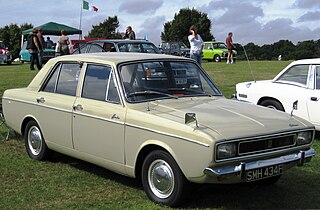
Rootes Arrow was the manufacturer's name for a range of cars produced under several badge-engineered marques by the Rootes Group from 1966 to 1979. It is amongst the last Rootes designs, developed with no influence from future owner Chrysler. The range is almost always referred to by the name of the most prolific model, the Hillman Hunter.

The Hillman Minx was a mid-sized family car that British car maker Hillman produced from 1931 to 1970. There were many versions of the Minx over that period, as well as badge-engineered variants sold by Humber, Singer, and Sunbeam.

Singer Motors Limited was a British motor vehicle manufacturing business, originally a bicycle manufacturer founded as Singer & Co by George Singer, in 1874 in Coventry, England. Singer & Co's bicycle manufacture continued. From 1901 George Singer's Singer Motor Co made cars and commercial vehicles.

The Hillman Husky was a line of British passenger vehicles manufactured between 1954 and 1970 by Hillman.

The Morris Minor is a small 4-seater car with an 850 cc engine manufactured by Morris Motors Limited from 1928 until 1934. The name was resurrected for another newer car for the same market in 1948.
The MG K-type Magnette is a motor car produced in the United Kingdom by MG from October 1932 to 1934.

The Triumph Super 7 is a car manufactured from 1927 until 1934 by the Triumph Motor Company. It was produced as a response to the success of the Austin 7 and was Triumph's first car to be made in large numbers. In 1933 the name was changed to the Triumph Super 8.

The Rover 10 was a small family car from the British Rover car company produced between 1927 and 1947.

The Wolseley Hornet is a six-cylinder twelve fiscal horsepower lightweight automobile which was offered as a saloon car, coupé and open two-seater as well as the usual rolling chassis for bespoke coachwork. Produced by Wolseley Motors Limited from 1930 until 1936, the Hornet was unveiled to the public at the end of April 1930. Wolseley had been bought from the receivers by William Morris in 1927.

The Rover Meteor was a short-lived 2½-litre or 2-litre medium-sized car made by The Rover Company Limited of Meteor Works Coventry. The new 2½-litre model was announced in mid-February 1930 to supplement Rover's Light Twenty which used the same engine and essentially the same chassis.

The Austin Light Twelve-Six is a 14 tax horsepower car with a 1496 cc engine that was introduced by Austin in January 1931. It was named by Austin Light Twelve to separate it from the well-established Austin Twelve. The general public then dubbed the original Twelve Heavy Twelve but Austin never used that name. The Light Twelve-Six remained in production until 1936.

The Hillman Fourteen is a medium-sized 4-cylinder car announced by Hillman's managing director Spencer Wilks, a son-in-law of William Hillman, at the end of September 1925. This new Fourteen substantially increased Hillman's market share and remained on sale into 1931. During this time it was the main product of the company.

The Riley 12/6 was a car made by the British Riley company from late 1932 to 1935.
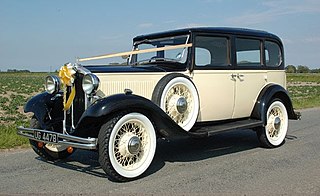
The Hillman Wizard is a six-cylinder car produced by Hillman between 1931 and 1933. Production began in April 1931 and continued until 1933.
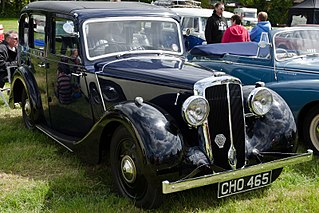
The Lanchester Fourteen Roadrider is a six-cylinder automobile introduced by the Lanchester Motor Company in the beginning of September 1936. It was named "Roadrider" for its special suspension features, and billed as the lowest-priced six-cylinder Lanchester ever offered. This car replaced the previous 12 hp Light Six model with a larger six-cylinder engine again in the Lanchester Eleven chassis and body.
The Rover Fourteen was a medium-sized family car and variants produced by the British Rover car company between 1924 and 1948. Civilian automobile production was interrupted in 1940 because of the war, but when the war ended in 1945, the Rover 14 returned to the market and remained available until replaced by the Rover 75 at the beginning of 1948.
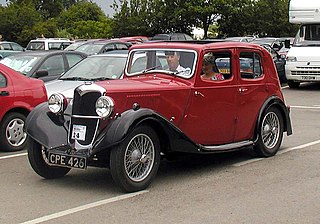
The Riley 12/4, or from 1936 the Riley 1½-litre, is a range of cars made from 1935 to 1938 by the British Riley company available with saloon, touring, and sports/racing coachwork,
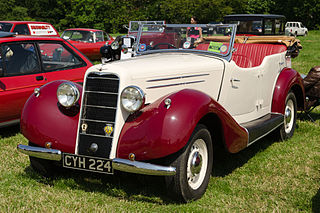
The Hillman Wizard 75, Hillman Twenty 70, Hillman Hawk and their long wheelbase variants Hillman Seven Seater and Hillman 80 models were a series of 20 horsepower medium priced 5-7 seater executive cars made by Hillman during the 1930s.

The Morris Oxford Six is a motor car produced by Morris of the United Kingdom from 1921 until 1926, and again from 1929 until 1935. Initially produced as a straight-six engined version of the Morris Oxford bullnose, the original Oxford Six was the first car produced by Morris with a six-cylinder engine, but proved to be unreliable. The versions produced from 1929 onwards were introduced as a replacement for the Morris Oxford 16/40.

































